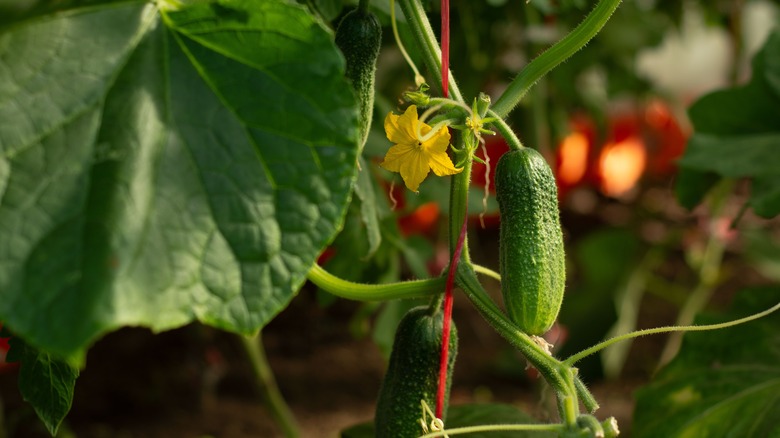Our Gardening Expert Tells Us The Top 3 Companion Plants For Healthy Cucumbers
Vegetable beds usually require a marked diversity, as it helps improve the plants' vigor and productivity, creating a thriving ecosystem in due time. That's why home gardeners experiment with companion planting. While the practice isn't deeply rooted in science, nor has it seen many experiments to back its claims, there is sufficient agreement (and anecdotal evidence) that planting different plants in proximity can generate several benefits. These benefits — depending on the combinations — encompass the likes of pest control, soil enrichment, natural trellises, weed suppression, and a habitat for beneficial insects, to name a few. So, if you're growing cucumbers in your garden, you may be wondering what plants make the best companions to the popular gourd.
Could coupling your cucumber vines with other plants yield something similar for your garden? Indeed, as our gardening expert, Shirley Bovshow, an award-winning Garden Designer and T2 Diabetes Advocate, voices in this House Digest exclusive interview. While also running her Foodie Gardener® blog and Instagram @shirleybovshow, Bovshow has amassed colossal experience over the years growing companion plants in her community garden. Though she admits, "Some seasons are better than others, but overall, I am satisfied with the results and so continue the practice." Given that, which three companion plants turned out to be the best for cucumbers? The award winner lists nasturtiums, dill, and radishes as her champions.
Myriad ways the three companion plants assist cucumbers
Shirley Bovshow elaborates on her choices in the House Digest exclusive interview, "Although nasturtiums are edible plants, in companion planting, they serve as 'trap crops.'" Growers of cucumbers are already privy to the host of pests that these vines invite — squash bugs, striped cucumber beetles, and squash beetles are the worst of the lot. However, with nasturtiums on their side, the insect pressure is reduced substantially, as they "attract these pests away from the cucumber plants and act like a 'pest magnet,'" dishes Bovshow. A study performed by Iowa State University found similar results, stating that squash bugs and cucumber beetles don't stand a chance against nasturtiums. Although, per Bovshow's experience, aphids and whiteflies suffer equally, if not worse. But once the companions have accomplished their objectives, she advises starting over. "Remove the infested nasturtiums from the garden and replace them with new plants."
Dill is brilliant at pest control, as it deters squash bugs while drawing in beneficial insects. Bovshow highlights, "Dill is an aromatic herb that attracts lacewings and parasitic wasps that feast on cucumber beetles, aphids, caterpillars, and other harmful pests." The cherry on the top? "It also attracts pollinators and shades the tender cucumber leaves." Likewise, radishes shield the cucumbers from cucumber and flea beetles. "During the heat of summer, radishes weaponize their distinct odor to confuse the beetles so they don't find their way to cucumbers." To benefit, allow the radishes to mature fully rather than pulling them out.
Other cucumber companions and the ones to avoid
Although nasturtiums, dill, and radishes do a fine job of protecting your plants, there are other companion plants you can grow next to cucumbers in your garden. Shirley Bovshow confesses to planting marigolds alongside cucumbers in her exclusive interview with House Digest, "Marigolds provide strong nematode control by releasing chemicals (thiophenes) through their roots to the soil." Such allelopathic properties are the most prominent in French and African marigolds, although soil temperature and the nematode variety play a significant role. The previously mentioned Iowa State University study also found compelling, nasturtium-like benefits with marigolds in terms of beetles and bug resistance.
Cucumbers also thrive alongside green beans in the garden, as well as their leguminous ilk, aka peas. They can share the same trellis if they're all of the vining variety. "Bean and pea plants can access or 'fix' the nitrogen in the air so that it is accessible in the soil to companion plants," explains Bovshow. However, you must work the remaining plant parts, such as roots and leaves, into the soil since most fixed nitrogen is otherwise lost when you harvest these vegetables. Also, note that peas can magnify the thrip infestation, so interplant based on your area's history. That being said, Bovshow warns against planting cucumbers with mint, as "it's an allelopathic, aggressive grower that crowds out cucumber plants." She finds potatoes equally incompatible, as they "attract similar pests and diseases, multiplying the negative impact on both plants."


